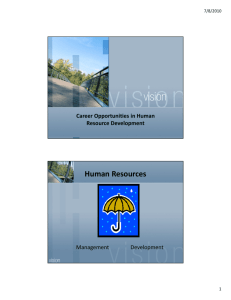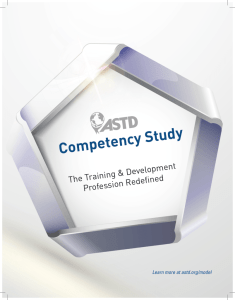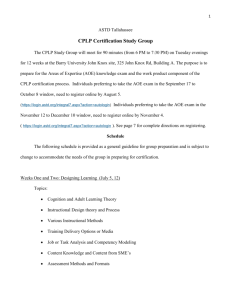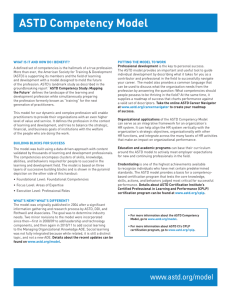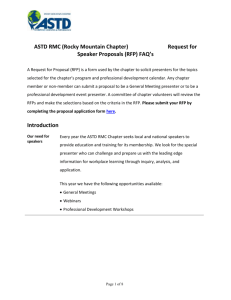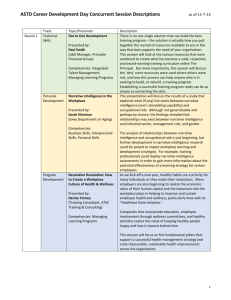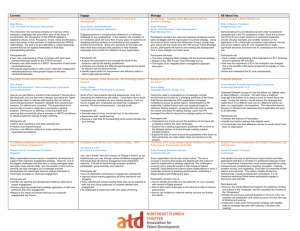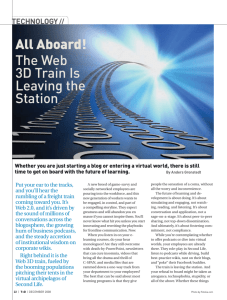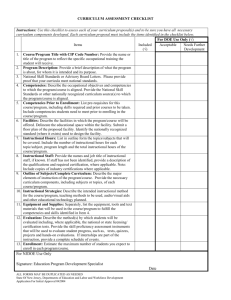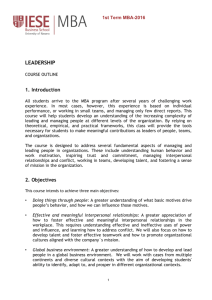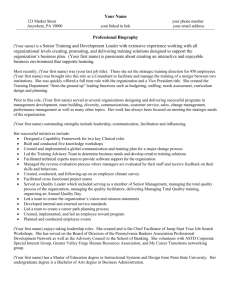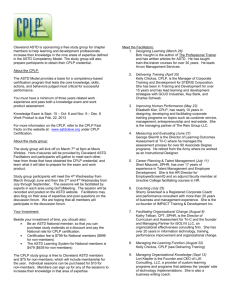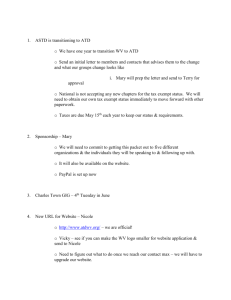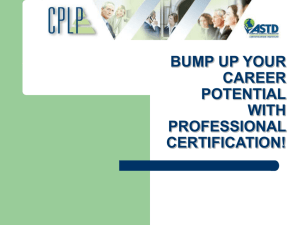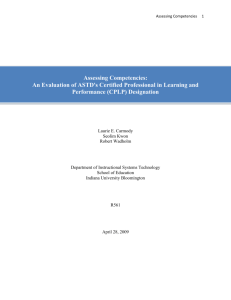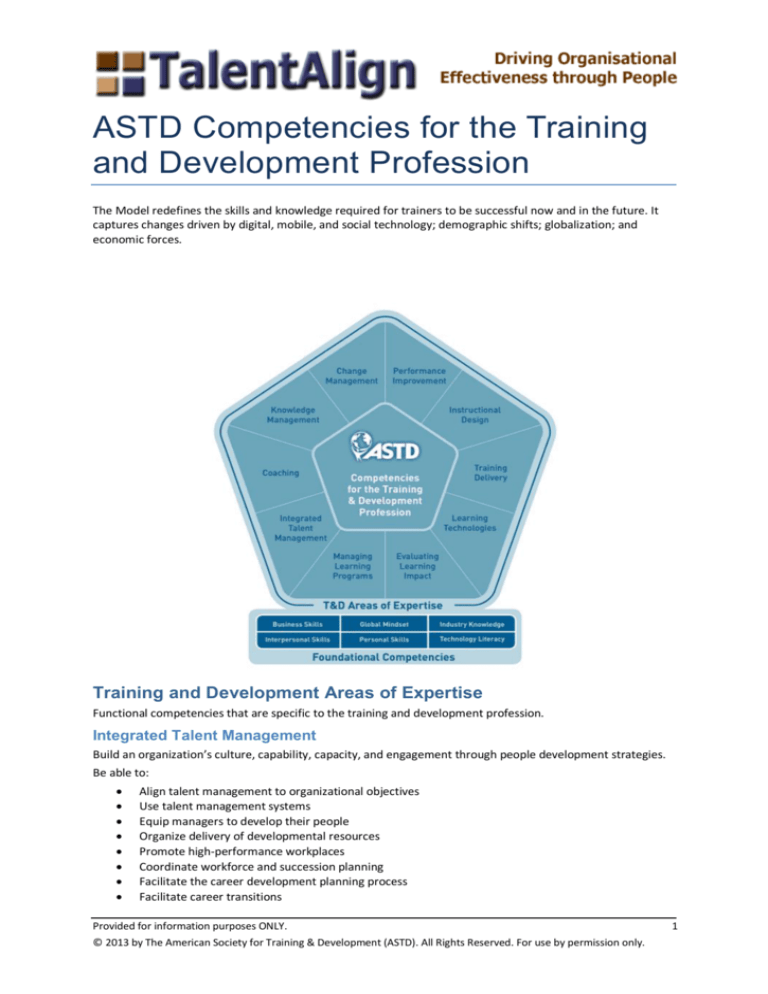
ASTD Competencies for the Training
and Development Profession
The Model redefines the skills and knowledge required for trainers to be successful now and in the future. It
captures changes driven by digital, mobile, and social technology; demographic shifts; globalization; and
economic forces.
Training and Development Areas of Expertise
Functional competencies that are specific to the training and development profession.
Integrated Talent Management
Build an organization’s culture, capability, capacity, and engagement through people development strategies.
Be able to:
Align talent management to organizational objectives
Use talent management systems
Equip managers to develop their people
Organize delivery of developmental resources
Promote high-performance workplaces
Coordinate workforce and succession planning
Facilitate the career development planning process
Facilitate career transitions
Provided for information purposes ONLY.
© 2013 by The American Society for Training & Development (ASTD). All Rights Reserved. For use by permission only.
1
Support engagement and retention efforts
Implement individual and organizational assessments
Use talent management analytics to show results and impact
Coaching
Apply a systematic process to improve others’ ability to set goals, take action, and maximize strengths.
Be able to:
Establish coaching agreement
Establish trust and intimacy with the client
Display coaching presence
Demonstrate active listening
Ask powerful questions
Use direct communication
Create awareness
Design learning opportunities
Develop goals and plans
Manage progress and accountability
Meet ethical guidelines and professional standards
Knowledge Management
Capture, distribute, and archive intellectual capital to encourage knowledge-sharing and collaboration.
Be able to:
Advocate knowledge management
Benchmark knowledge management best practices and lessons learned
Encourage collaboration
Facilitate social learning
Establish a knowledge culture
Support the development of a knowledge management infrastructure
Leverage technology
Manage information life cycle
Design and implement knowledge management solutions
Transform knowledge into learning
Evaluate knowledge management success
Change Management
Apply a systematic process to shift individuals, teams, and organizations from current state to desired state.
Be able to:
Establish sponsorship and ownership for change
Build involvement
Create a contract for change
Conduct diagnostic assessments
Provide feedback
Facilitate strategic planning for change
Support the change intervention
Encourage integration of change into organizational culture
Manage consequences
Evaluate change results
Performance Improvement
Apply a systematic process for analyzing human performance gaps and for closing them.
Be able to:
Identify the customer
Conduct performance analysis
Provided for information purposes ONLY.
© 2013 by The American Society for Training & Development (ASTD). All Rights Reserved. For use by permission only.
2
Conduct cause analysis
Analyze systems
Gather data
Incorporate customer and stakeholder needs
Select solutions
Manage and implement projects
Build and sustain relationships
Evaluate results against organizational goals
Monitor change
Instructional Design
Design and develop informal and formal learning solutions using a variety of methods.
Be able to:
Conduct a needs assessment
Identify appropriate learning approach
Apply learning theory
Collaborate with others
Design a curriculum, program, or learning solution
Design instructional material
Analyze and select technologies
Integrate technology options
Develop instructional materials
Evaluate learning design
Training Delivery
Deliver informal and formal learning solutions in a manner that is both engaging and effective.
Be able to:
Manage the learning environment
Prepare for training delivery
Convey objectives
Align learning solutions with course objectives and learner needs
Establish credibility as an instructor
Create a positive learning climate
Deliver various learning methodologies
Facilitate learning
Encourage participation and build learner motivation
Deliver constructive feedback
Ensure learning outcomes
Evaluate solutions
Learning Technologies
Apply a variety of learning technologies to address specific learning needs.
Be able to:
Use technology effectively across the different areas of expertise
Identify when and how to use technology as a training and development solution
Evaluating Learning Impact
Use learning metrics and analytics to measure the impact of learning solutions.
Be able to:
Identify customer expectations
Select appropriate strategies, research design, and measures
Communicate and gain support for the evaluation plan
Manage data collections
Provided for information purposes ONLY.
© 2013 by The American Society for Training & Development (ASTD). All Rights Reserved. For use by permission only.
3
Analyze and interpret data
Apply learning analytics
Make recommendations to aid decision-making
Foundational Competencies
Knowledge, skills, abilities, and behaviors that are required for job success in most
professional occupations.
Foundational Competencies
Knowledge, skills, abilities, and behaviors that are required for job success in most professional occupations.
Business Skills
Be able to:
Analyze needs and propose solutions
Apply business skills.
Drive results
Plan and implement assignments
Think strategically
Innovate
Global Mindset
Be able to:
Accommodate cultural differences
Convey respect for different perspectives
Expand own awareness
Adapt behavior to accommodate others
Champion diversity
Leverage diverse contributions
Industry Knowledge
Be able to:
Maintain own professional knowledge
Keep abreast of industry changes and trends
Build industry sector knowledge
Interpersonal Skills
Be able to:
Build trust
Communicate effectively
Influence stakeholders
Network and partner
Demonstrate emotional intelligence
Personal Skills
Be able to:
Demonstrate adaptability
Model personal development
Technology Literacy
Be able to:
Demonstrate awareness of technologies
Use technology effectively
For more information from ASTD, or to purchase and use the Model, click here.
Provided for information purposes ONLY.
© 2013 by The American Society for Training & Development (ASTD). All Rights Reserved. For use by permission only.
4

